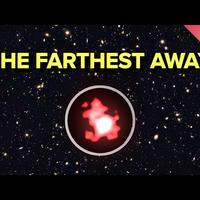What is Farthest Away?
If you've ever looked at the night sky, you've probably wondered, what's out there?
And how far does it extend?
Well … you're in good company.
For thousands of years, humans have been curious about what's off the edge of the map.
Today, science may finally be close to giving us answers to even bigger questions: Does
the map even have an edge?
And what's the farthest away anything can be?
[OPEN]
When humans first started mapping their location in the world around the 6th century BC, the
edge of the map was… not very far away.
Our earliest world maps showed flat, circular views of the Earth, like you'd draw from
a mountaintop…if the Earth was flat… which it's not.
In fact, the Greek scholar Eratosthenes figured out the Earth was basically spherical around
240 BC.
He used the midday sun to calculate the circumference of the Earth and got results within 15% of
the actual value (40,075 km).
But still, for centuries, maps were flat, centered around whoever drew it, whether they
were in Europe, the Arab world, or even China.
At the edges, mapmakers would often inscribe, “here be lions” to indicate unknown lands…
not “here be dragons” like I've always believed.
Explorers continued to exchange knowledge and “discover” places that people already
lived, and our picture of the world expanded.
Our world map was finally complete with the discovery of Antarctica in the 1820s.
Suddenly, the edge of the map became the sky itself.
In the 1830s, we discovered that stars are vastly farther away than planets–duh.
We figured this out by measuring how different astronomical objects shift relative to their
background–a phenomenon called parallax.
The edge of our map now extended beyond our solar system to the galaxy.
Of course, by the 1900s we still thought our Milky Way galaxy was the whole universe.
Here's the challenge astronomers faced: If one star is dimmer than another, is it
farther away?
Or is it just smaller?
In the early 1900s, astronomer Henrietta Swan Leavitt realized a class of stars called Cepheids
pulsate, bright and dim, and every Cepheid that pulsates at the same rate has the same
brightness.
If two Cepheid stars are pulsating at the same rate, and one's dimmer than the other,
that means one is actually farther away.
And since there were pulsating Cepheid stars whose actual distances we already knew, this
let us build a cosmic measuring stick.
In 1925, when Edwin Hubble looked at the brightness of variable stars in a smudge called Andromeda,
they appeared much dimmer than their pulsing rate predicted, and Hubble realized these
stars were too far away to be in the Milky Way.
Andromeda was another galaxy.
We now know that light from Andromeda, which on a dark night is actually the most distant
thing you can see with your naked eye.
Using bigger eyes–like the giant space telescope named for Hubble, we've seen images in which
every speck is its own galaxy, the farthest of which is more than 13 billion light years
away, almost the oldest light we can see.
When we look at a galaxy like this one, we see it as it was when the universe was just
400 million years old…before Earth or our Sun even existed yet!
We also don't see distant galaxies where they currently are.
Certain stars, like our sun, emit light in characteristic patterns, depending on their
atomic makeup.
These “absorption spectra” are like a luminous fingerprint.
But if we see that pattern at longer, redder, wavelengths than we expect, we know the object
is actually moving away from us, its light has been stretched by the expanding universe.
Astronomers call this redshift.
So in the time light takes to reach us from a distant galaxy, it's moved farther away.
So, when we look at a distant galaxy, we're seeing as it was when it was much younger,
and much closer.
Imagine your friend sent you an email from a train saying she was just crossing the bridge
leaving town.
By the time the email reaches you, she's no longer on the bridge, and probably already
farther away.
Here's where the physics gets really freaky/weird.
Since it was given off, the light from a distant galaxy like GN-z11 traveled more than 13 billion
light years to get to us, but that galaxy today is almost 46 billion light years from
Earth.
And it turns out, the further we look at distant objects, the faster they are moving away from
us.
This means there's some distance, way out there, beyond which galaxies are receding
faster than the speed of light, because space itself is expanding that fast.
The light they give off will always be moving away from us.
We can never see that far.
That's the limit of our observable universe.
Beyond that limit, we're nearly certain there are other parts of the universe whose
light we will never see.
This means no one really knows how big the actual universe is.
Some say it's at least 250 times bigger than our observable universe, others calculate
it could exceed 10^10^10^1222 megaparsecs, which is a vast and complicated and... ridiculous
number.
Others say there is no edge at all.
There's one edgeless theory that says the the fabric of the universe may be folded to
up like a torus — a fancy donut shape.
That would mean not only no edge to our cosmic map, but no beginning or end to it.
What is farthest away may not be a question that we can answer, however, we're driven
by the same curiosity that drove those very first mapmakers, thousands of years ago.
Just that their maps were a bit smaller.
Stay curious, and be careful… there be lions
out there.

